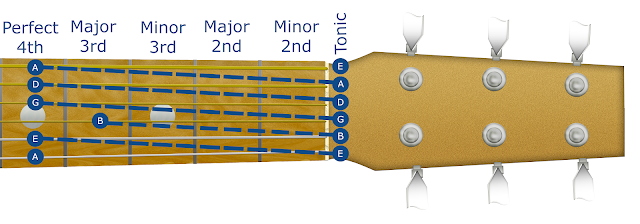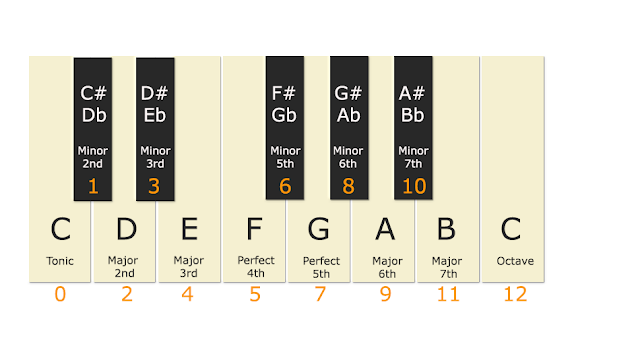You will learn:
- What an interval is
- The name of the 12 interval positions
- That you can play the same melody in different places, as long as the intervals between notes are the same
- How the guitar is tuned, helps you to learn where to find your interval notes
- What the place markers on the fifth fret and seventh fret of your guitar are for
Interval names
In music theory, each of these twelve positions in the musical alphabet has a special name assigned to it.
That name references how far away it is from the first note played in a particular scale. The correct musical term for this distance between notes is an interval.
I’m going to show you the names of these 12 intervals now because as we move through the lessons you’ll learn:
- the relationship they have with each other
- how to move between intervals quickly, without having to memorise the fretboard.
I’m going to start by demonstrating this on the piano keys and then we’ll apply the same principle to the guitar fretboard.
So, in this example, we are once again starting on the note C, and moving up 12 steps until we land back at the note C. We could start with any note, the same rules would apply, but I’m going to be sticking with C.
Our first note, C is called the tonic. You’ll also hear this referred to as the root note. This first note (whatever it happens to be) is like the home-base of your song. It’s the note your song will probably start on and it’s the note that your song will want to resolve back to, to finish.
All of the other white keys on the piano are major notes - major 2nd, major 3rd, perfect 4th, perfect 5th, major 6th and major 7th.
All of the black keys on the piano are minor notes, and they are a half step (or semi-tone) between our whole notes.
Moving from a white key to a black key on the piano is known as a half-step (or a semi-tone). Moving from a white key, to the next white key without a step in between is known as a whole step (or a whole tone).
We’ve already learned in lesson one that on the piano, not all of the whole notes have a black key between them. Sometimes two white whole notes are right next to each other. That’s the same on the guitar. Sometimes there are two whole notes right next to each other on the fretboard.
There aren’t any half steps between the notes B and C, or between the notes E and F.
Finding intervals on the guitar fretboard
On the guitar, finding our whole notes and half notes can seem more complicated.
We have 6 strings and each string has all 12 notes. So, how do we know which are the major notes, and which are the minor notes on each string? There are no black keys or white keys to tell us which are the whole steps and which are the half steps or the sharps and flats. How do we find the do, re, mi, fa, so la, ti, do notes on the guitar neck?
In order to become a skilled guitar player, you need to understand when the next fretted note is a whole step higher than the last, and when it is a half step higher. That’s what I’m going to teach you now.
Understanding half steps and whole steps
In music theory, there is no ‘black key’ or ‘half step’, or ‘semitone’ (all terms for the same thing) between the notes B and C, or between the notes E and F.
All the other notes have a semitone, or a sharp or flat, or black key (all terms for the same thing) between them.
So, let’s work our way up the fifth string on the guitar which is the A string. We’ll move up a half step each time, unless we’re going from B to C or E to F. When we hit B, we’ll go straight to C. When we hit E, we’ll go straight to F.
A#, B, C, C#, D, D#, E, F, F#, G, G#, A
So you’ll notice that there are 12 notes in that sequence, and we end up on the12th fret of the guitar string - where we can see the double dots on the guitar neck.
Let’s see how this works on the E string, just so you are comfortable with what you’ve learned:
F, F#, G,G#, A, A#, B, C, C#, D, D#, E
So with the knowledge you can play any melody on any string, horizontally up and down the fretboard.
It doesn’t matter which notes you play, the important thing is the space, or the interval between the notes.
You can start on any note on the fretboard, and play Happy Birthday to You. That’s not because of the notes you'll be playing, but because of the spaces, or intervals, in between each note.
Playing interval notes across guitar strings
Knowing the intervals between notes along a single string is useful. But of course, when you play guitar you want to play vertically, on multiple strings at the same time. You have six strings to play on, you don’t want to be restricted to moving up and down one string.
So you need to know where to find our intervals, in relation to each other, across the strings, vertically.
The key to understanding that is to look at how the guitar is tuned. Once you understand that you’ll be able to find the intervals between notes across all six strings, not just on one individual string.
That’s what I’m going to show you next.
How the guitar is tuned
The guitar is tuned at intervals of perfect fourths, and major thirds.
Let’s look the names of our intervals again, to help you understand how this works.
The first note on the guitar is the note E, which is on the 6th string.
The string below this is tuned to the interval of a perfect fourth in relation to E.
So. let’s step through the letters of the musical alphabet (from E) until we get to the interval of a perfect fourth:Let’s see how this works on the E string, just so you are comfortable with what you’ve learned:


Our tonic is G Our flat 2nd is G# Our major 2nd is A Our flat third is A# And our major third is B So, all of the strings are tuned to intervals of a perfect fourth, apart from the B string, which is tuned to an interval of a major third to the G string above it. I’m taking the time to share this knowledge with you because understanding the concept will help you to build your own melodies on the guitar by understanding where the intervals are in relation to one another. This will become more obvious as we move through the course.
The perfect fourth interval is below the root note (usually)
For now, you’ve just discovered that your perfect fourth interval note will be below your tonic, or root note, in any major key (unless it happens to be on that B string, in which case we need to move it up half a step, just because of how the B string is tuned). Remember, the one chord, the four chord, and the five chord in any major key, are major chords. So, you’ve just found how to find the root notes of your one chord and your four chord, in any major key! You might not know what to do with that information at the moment, but trust the process I’m taking you through, and it will become clear.Notes at the fifth fret of the guitar
Before we end this lesson, there’s one more thing to point out. You’ll notice that the (E)ADGBE pattern is repeated on the fifth fret, from the 5th string down. This is why there is a place marker on the 5th fret. It’s a visual cue to remind you how to find those notes in this section of the guitar neck.
Notes at the seventh fret of the guitar
Whilst we’re looking at these visual cues, let’s understand what the place marker dots at the seventh fret of the guitar are for.
We can find our open notes (EADBGE) on the string directly below, if we put our finger on the seventh fret.
So, let’s look at the open E. If I want to find the note E on the A string below it, I can press down on the seventh fret:

If I want to find the note A on the D string below it, I can press down on the seventh fret.
This is because of how the guitar is tuned. The notes on the seventh fret (and the eight fret in the case of the B string) are a perfect fifth interval from the open note of the string when it’s played in the open position.
So, walking down the A sting, we have A#, B, C, C#, D, D#, and E.
A note played on the seventh fret, is the same note as the open string above it.
Guitar practice journal
Download the Guitar Practice Tracker today. It will help to keep you motivated and give you a visual representation of your progress, and areas of focus throughout the year.
A guitar journal will enable you to:- Set personalised goals and monitor your progress
- Identify the number of hours or days you've spent on a particular skill
- Provide a quick reference to the notes and chords in a particuar key
- List the songs you know and sort by key, capo placement, artist, and chord progression
- Link directly to your favourite YouTube videos and tutorials
Download the Guitar Practice Tracker
Go to Lesson 3: Using intervals to find notes and chords in any key



